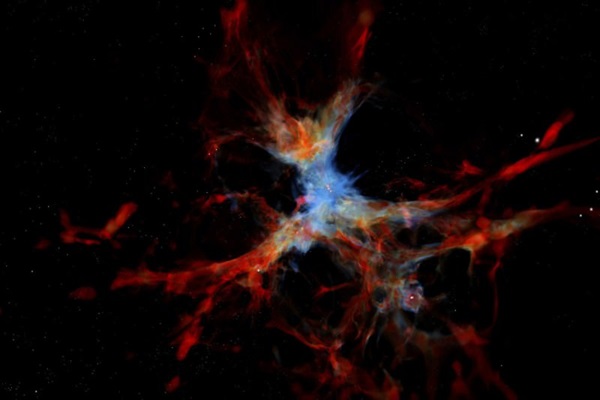Key Takeaways:
The universe is an empty place — or is it? The cold gas filaments that span the space between galaxies are faint and hard to see, but astronomers believe this difficult-to-detect gas is responsible for the evolution of galaxies over time. With the arrival of the Keck Cosmic Web Imager, or KCWI, at one of the world’s largest optical telescopes on January 18, this “cosmic web” will finally come into focus.
Caltech has just shipped this new instrument to its final home at the W.M. Keck Observatory atop Mauna Kea in Hawaii. The KCWI is designed to simultaneously obtain images and spectra of objects, including the gas filaments that comprise what astronomers call the cosmic web. Obtaining spectra will provide researchers with information about the filaments’ mass, velocity, and composition, providing a never-before-seen look at their interactions with the galaxies they surround.
KCWI can do all this because it’s an integral field spectrograph. Integral field spectrographs differ from traditional slit spectrographs in that they’re able to obtain information about large, extended objects in a single shot. Slit spectroscopy involves placing a narrow slit over the object of interest to break the light apart and obtain a spectrum. While this technique works well for compact or visibly small objects, such as stars, it makes obtaining spectra from extended objects, such as galaxies or the huge, intergalactic medium-spanning web of gas that connects them, so time-intensive that it may as well be unfeasible. Integral field spectroscopy changes the game by dividing the entire field of view into several slits to gather information across the image simultaneously. KCWI divides each image into 24 slits using a series of mirrors, returning a “cube” of data that contains not only information about its targets in space, but in wavelength as well. This data cube can reveal whether and how the object is moving, as well as its composition, temperature, and mass.
“We know the gas around galaxies is ultimately fueling them, but it is so faint — we still haven’t been able to get a close look at it and understand how this process works,” said Christopher Martin, a Professor of Physics at Caltech and the team leader of the KCWI project, in a press release. It is Martin’s hope that the KCWI will reveal the details necessary about the cosmic web to finally determine its role in galaxy evolution.
One of the models used to describe the cosmic web is the cold flow model, which states that the gas filaments stream into galaxies over time, where the gas is funneled into the center of the galaxy and eventually condenses to form new stars. This model is supported by evidence found by Martin’s team in 2015 using the precursor to the KCWI, the Cosmic Web Imager (CWI). The team studied the kinematics of the gas surrounding a distant galaxy and found a large, rotating disk of gas connected to an extragalactic gas filament. According to Martin, this find was “the smoking gun for the cold flow model.”
KCWI follows in CWI’s footsteps, but it’s a significantly better instrument than its predecessor. Not only will it be coupled with one of the largest optical telescopes on Earth at one of the darkest sites on the planet, it has the highest spectral resolution available of any such instrument and incorporates several other technological advances into its design and build as well. Unlike CWI, KCWI is also designed for a high level of customizability, making it an extremely versatile instrument. While Martin plans to use it to unlock the mysteries of the cosmic web, other astronomers can use KCWI to study other objects that run the gamut from extremely young, still-forming stars to the supermassive black holes at the centers of galaxies.
The first phase KCWI, which covers wavelengths between 3,500-5,600 Angstroms, began its several-day trek to Hawaii this morning. Once it arrives on January 18, it will be transported up the mountain to the 14,000-foot summit, where it will then undergo months of checks and alignment tests. But once those tests are complete, KCWI will get to work high above the clouds, revealing new information about the universe. The instrument’s second phase, slated to begin construction soon, will complete the package by covering wavelengths into the red end of the spectrum, out to 10,400 Angstroms.










